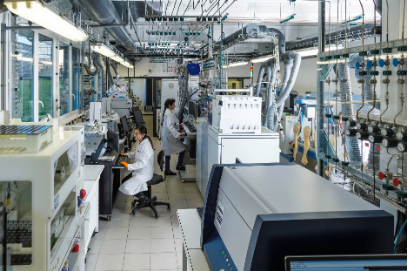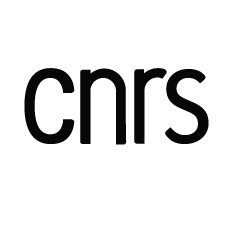CATSUSCHEM Team
![[Translate to English:] Image accueil CATSUSCHEM](/fileadmin/user_upload/laboratoires/uccs/Recherche/Catalyse_heterogene/CATSUSCHEM/Image_accueil_CATSUSCHEM.png)
Team leader: Dr Mickael Capron
Assistant team leader : Dr Vitaly Ordomsky
Team leader foreword
Created in January 2025, the CatSusChem team comprises ten permanent staffs, around thirty PhD students and ten post-docs. Our activities focus on the advanced catalytic upgrading of biomass for biorefineries, as well as the upgrading of pollutants such as CO2. All this research takes into account the principles of the bioeconomy and the circular economy.
We integrate expertise in heterogeneous and enzymatic catalysis, process and reactor engineering, and high-throughput catalytic screening for the valorization of small molecules (C1, H2) and bio-sourced platform molecules from the lignocellulosic and oleaginous chain (C1 to C6). We are also developing original fundamental activities, including pioneering work in hybrid catalysis combining chemo- and biocatalysis in a single reactor.
Team members
| Nom | Fonction | Tutelle |
|---|---|---|
| M. Antuch | Junior Professor Chair | Centrale Lille |
| Mickael Capron | Assistant Professor | Univ. Lille |
| Franck Dumeignil | Professor | Univ. Lille |
| Jean-Sebastien Girardon | Assistant Professor | Univ. Lille |
| Egon Heuson | Researcher | Centrale Lille |
| Benjamin Katryniok | Professor | Centrale Lille |
| Andrei Khodakov | CNRS Research Director | CNRS |
| Vitaly Ordomsky | CNRS Researcher | CNRS |
| Sebastien Paul | Professor | Centrale Lille |
| Mirella Virginie | Assistant Professor | Centrale Lille |
| Olena Vovk | CNRS Researcher | CNRS |
Photocatalysis for C1 molecules
Methane, an abundant molecule on our planet, plays an important role as a greenhouse gas, with an environmental impact 30 times greater than that of carbon dioxide. The development of technologies to convert methane in an efficient and environmentally-friendly way is crucial to the sustainable use of resources, whether renewable or fossil. Our commitment to this approach focuses on the photocatalytic activation of methane. This theme is supported by four ANR and PEPR projects. As part of our research, we have proposed new photocatalytic reaction schemes for the coupling of methane to ethane, the selective oxidation of methane to CO and the carbonylation of methane to produce acetic acid. We have also proposed new processes based on photothermocatalysis and photoelectrocatalysis. We occupy a leading position in this field and intend to pursue these topics by proposing new processes and approaches for the conversion of methane using solar cells, for example, for new reactions involving the development of innovative catalytic materials.
Principal Investigators : V. Ordomsky, M. Antuch
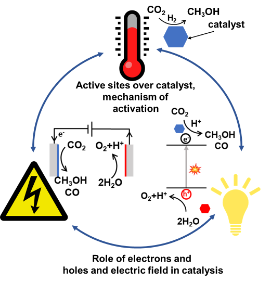
Hydrogenation of CO2 to methanol and olefins
One of the team's main research activities focuses on the valorization of CO2 into valuable products such as light olefins. We are involved in several valorization projects, such as the ANR DEZECO project and the HORIZON 2020 TAKE-OFF project, which focus on the synthesis of light olefins and jet fuel respectively. Our main objective is to convert CO2 into light olefins or methanol with high conversion rates and selectivity. We have made significant progress in this direction by designing new composite materials and identifying the reaction mechanism that will enable us to increase selectivity. The research carried out on these projects has enabled us to establish close contacts with companies specializing in the production of energy from renewable sources. We are now focusing on new approaches to CO2 conversion using liquid metals, electrocatalytic and photocatalytic CO2 reduction.
Principal Investigators : A. Khodakov, V. Ordomsky, M. Virginie, S. Paul, F. Dumeignil.
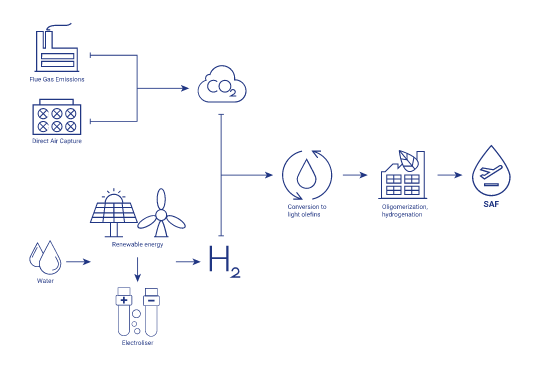
Hybrid catalysis
Hybrid catalysis combines chemical and biological catalysts to create multicatalytic systems with enhanced properties. This approach overcomes the limitations of conventional chemical and biological catalysis, offering greater diversity and reaction efficiency. For example, combining enzymes with supported metal nanoparticles enables more selective and efficient chemical transformations, unattainable by traditional methods.
The CatSusChem team at UCCS is using this new field of research to convert biobased compounds, particularly those derived from lignocellulosic biomass, into polymer precursors, surfactants, pharmaceuticals and many other types of high value-added small molecules. To this end, the team is particularly interested in the rational combination, aided by high-throughput screening, of the two catalyst families, in order to achieve the most integrated processes possible and, ultimately, new, highly efficient and recyclable multi-catalytic hybrid materials. Originally created around the combination of approaches to chemical catalysis (homogeneous/heterogeneous) and biocatalysis (enzymatic and fermentative), the concept has gradually expanded to include the combination of these with new approaches, including electrocatalysis, photocatalysis, plasmonic catalysis and mechanochemistry.
Principal investigators : E. Heuson, M. Capron, J.-S. Girardon, M. Antuch, V. Ordomsky
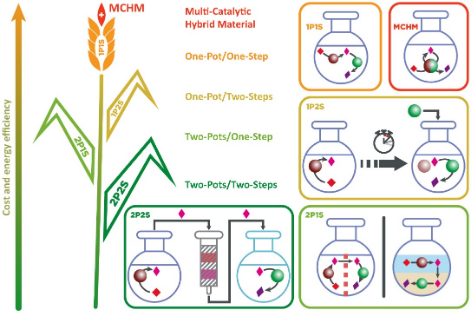
High-speed reaction - Artificial intelligence
The development of theoretical and quantum chemistry, coupled with improved computing power, has opened up the possibility of translating into a more predictive science. Even so, these approaches still require experimental validation to verify the accuracy of the results. More recently, the revolution brought about by artificial intelligence, and more specifically machine learning, has spread to chemistry, opening up the possibility of developing catalysts and processes in silico. However, these approaches require very large amounts of data for model learning, and it is with this in mind that UCCS, through its teams in theoretical chemistry and catalysis, and above all through its high-throughput synthesis, testing and characterization platforms (i.e.: REALCAT), has begun to participate in the development of this new theme. Several projects are currently underway to 1) replace the computing power required for theoretical chemistry (DFT calculations, etc.) with predictive determination of the associated energies, 2) accelerate optimization of catalytic reaction conditions by predicting the most promising parameters to be tested (Bayesian optimization), or 3) design new chemical and biological catalysts by establishing structure-activity relationships based on large-scale screening campaigns processed by neural networks. A nascent theme at UCCS, it has already led to a number of noteworthy initial results, and will be perpetuated in the medium term by the development of projects in a wide range of fields, from biomass valorization to polymer recycling, via the synthesis of commodity products.
Principal investigators : S. Paul, F. Dumeignil, E. Heuson
